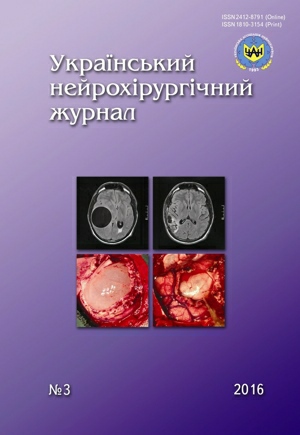Balloon kyphoplasty: errors and complications
DOI:
https://doi.org/10.25305/unj.78771Keywords:
spine fracture, balloon kyphoplasty, complicationsAbstract
Introduction. Percutaneous balloon kyphoplasty was developed for vertebral compression fractures minimally invasive treatment. Subsequently, this technique has been widely and successfully used for traumatic and tumor spine fractures treatment. However, the data complications during manipulation are insufficient in the literature.
Goal. Estimate the frequency and nature of intraoperative and postoperative complications during balloon kyphoplasty.
Materials and methods. We have studied the results of treatment 63 patients (a total 75 levels of compression), which percutaneous balloon kyphoplasty was performed. We present patients with traumatic and osteoporotic thoracolumbar fractures ages of 19 to 85 years. Women were 35, men were 28.
Results and discussion. Neurological and infectious complications did not occur. In 3 cases (4%) was observed paravertebral bone cement leakage, in 1 case (1.3%) intradiscal and 1 case (1.3%) intravascular. The total percentage of complications is comparable with literature data for this operations type. Clinically significant manifestations of these incidents had not.
Conclusions. Percutaneous balloon kyphoplasty — a safe method of minimally invasive treatment of thoracolumbar spine fractures. Careful planning and technically correct execution of its by trained staff allows us to reduce complications to a minimum.
References
1. Pedachenko EG, Kuschaev SV. Punktsionnaya vertebroplastika [Percutaneous vertebroplasty]. Kiev: A.L.D.; 2005. Russian.
2. Theodorou DJ, Theodorou SJ, Duncan TD, Garfin SR, Wong WH. Percutaneous balloon kyphoplasty for the correction of spinal deformity in painful vertebral body compression fractures. Clinical Imaging. 2002;26(1):1-5. [CrossRef] [PubMed]
3. Kerimbayev TT, Melnikov VG, Urunbaev EA, Kisaev EV, Erizhepbekov BS. Opyt primeneniya ballonnoy kifoplastiki pri travmaticheskom perelome pozvonochnika. [Balloon kyphoplasty experience in case of traumatic spinal fracture] The Journal Neurosurgery and Neurology of Kazakhstan. 2013;2(31):22-7. Russian. Available at: http://www.neurojournal.kz/journal-archive/2-(31)-2013.html
4. Becker S, Meissner J, Bartl R, Bretschneider W, Ogon M. Preliminary results with modified techniques of balloon kyphoplasty for vertebra plana, traumatic fractures and neoplasms. Acta Orthop. Belg. 2006;72(2):187-93.[CrossRef] [PubMed]
5. Hartmann F, Gercek E, Leiner L, Rommens PM. Kyphoplasty as an alternative treatment of traumatic thoracolumbar burstfractures Magerl type A3. Injury Int. J. 2012;43:409-15. [CrossRef] [PubMed]
6. Choe DH, Marom EM, Ahrar K, Truong MT, Madewell JE. Pulmonary embolism of polymethyl methacrylate during percutaneous vertebroplasty and kyphoplasty. Am. J. Roentgenol. 2004;183(4):1097-102. [CrossRef] [PubMed]
7. Phillips FM, Todd Wetzel F, Lieberman I, Campbell-Hupp M. An in vivo comparison of the potential for extravertebral cement leak after vertebroplasty and kyphoplasty. Spine 2002; 27(19): 2173-2178.[CrossRef] [PubMed]
8. Taylor RS, Fritzell P, Taylor RJ. Balloon kyphoplasty in the management of vertebral compression fractures: an updated systematic review and meta-analysis. Eur Spine J. 2007;16(8):1085-100. [CrossRef] [PubMed]
9. Lin EP, Ekholm S, Hiwatashi A, Westesson PL. Vertebroplasty: cement leakage into the disc increases the risk of new fracture of adjacent vertebral body. Am. J. Neuroradiol. 2004,25(2):175-80. [CrossRef] [PubMed]
10. Harrop JS, Prpa B, Reinhardt MK, Lieberman I. Primary and secondary osteoporosis’ incidence of subsequent vertebral compression fractures after kyphoplasty. Spine. 2004;29(19):2120-5. [CrossRef] [PubMed]
11. Lavelle WF, Cheney R. Recurrent fracture after vertebral kyphoplasty. Spine J. 2006;6(5):488-93. [CrossRef] [PubMed]
12. Moon ES, Kim HS, Park JO, Moon SH, Lee HM, Shin DE, Ha JW, Ahn EK, Shim DJ, Chung JY. The incidence of new vertebral compression fractures in women after kyphoplasty and factors involved. Yonsei Med. J. 2007;48:645-52. [CrossRef] [PubMed]
13. Nussbaum DA, Gailloud P, Murphy K. A review of complications associated with vertebroplasty and kyphoplasty as reported to the Food and Drug Administration medical device related. J Vasc Interv Radiol. 2004;15(11):1185-92. [CrossRef] [PubMed]
14. Kalteis T, Luring C, Gugler G, Zysk S, Caro W, Handel M, Grifka J. [Acute tissue toxicity of PMMA bone cements]. Z Orthop Ihre Grenzgeb 2004;142(6):666-72. German. [CrossRef] [PubMed]
15. Maynard FM Jr, Bracken MB, Creasey G, Ditunno JF Jr, Donovan WH, Ducker TB, Garber SL, Marino RJ, Stover SL, Tator CH, Waters RL, Wilberger JE, Young W. International Standards for Neurological and Functional Classification of Spinal Cord Injury. American Spinal Injury Association. Spinal Cord. 1997;35(5):266-74. [CrossRef] [PubMed]
16. Masala S, Fiori R, Massari F, Simonetti G. Kyphoplasty: indications, contraindications and technique. Radiol. Med. 2005;110(1-2):97-105. [CrossRef] [PubMed]
17. Spivak JM, Johnson MG. Percutaneous treatment of vertebral body pathology. Journal of American Academy Orthopedic Surgery. 2005;13(1):6-17. [CrossRef] [PubMed]
18. Greene DL, Isaac Roman BA, Neuwirth M, Bitan F. The eggshell technique for prevention of cement leakage during kyphoplasty. Journal of Spinal Disorders & Techniques. 2007;20(3):229-32. [CrossRef] [PubMed]
Downloads
Published
How to Cite
Issue
Section
License
Copyright (c) 2016 Borys Pavlov

This work is licensed under a Creative Commons Attribution 4.0 International License.
Ukrainian Neurosurgical Journal abides by the CREATIVE COMMONS copyright rights and permissions for open access journals.
Authors, who are published in this Journal, agree to the following conditions:
1. The authors reserve the right to authorship of the work and pass the first publication right of this work to the Journal under the terms of Creative Commons Attribution License, which allows others to freely distribute the published research with the obligatory reference to the authors of the original work and the first publication of the work in this Journal.
2. The authors have the right to conclude separate supplement agreements that relate to non-exclusive work distribution in the form of which it has been published by the Journal (for example, to upload the work to the online storage of the Journal or publish it as part of a monograph), provided that the reference to the first publication of the work in this Journal is included.









